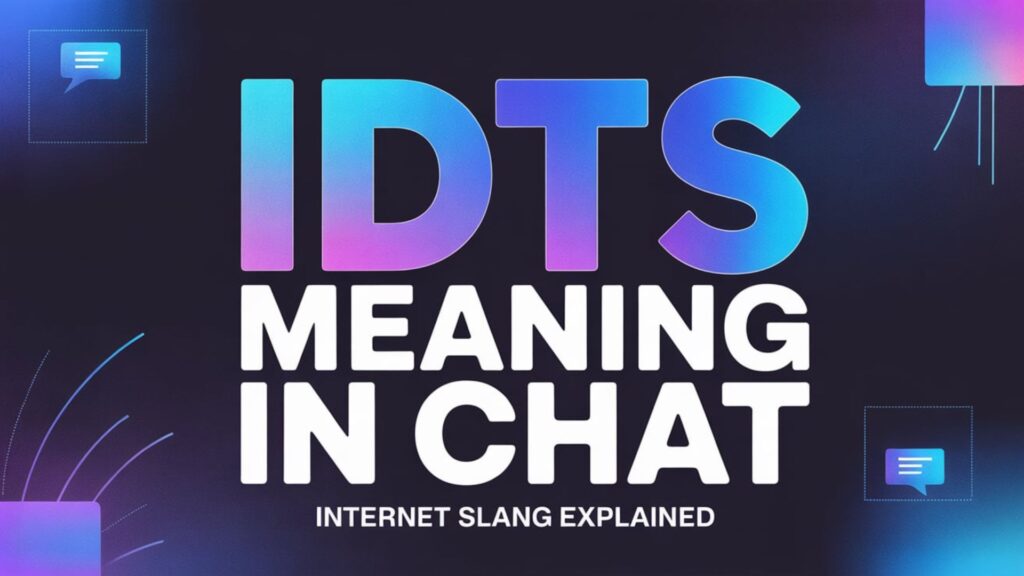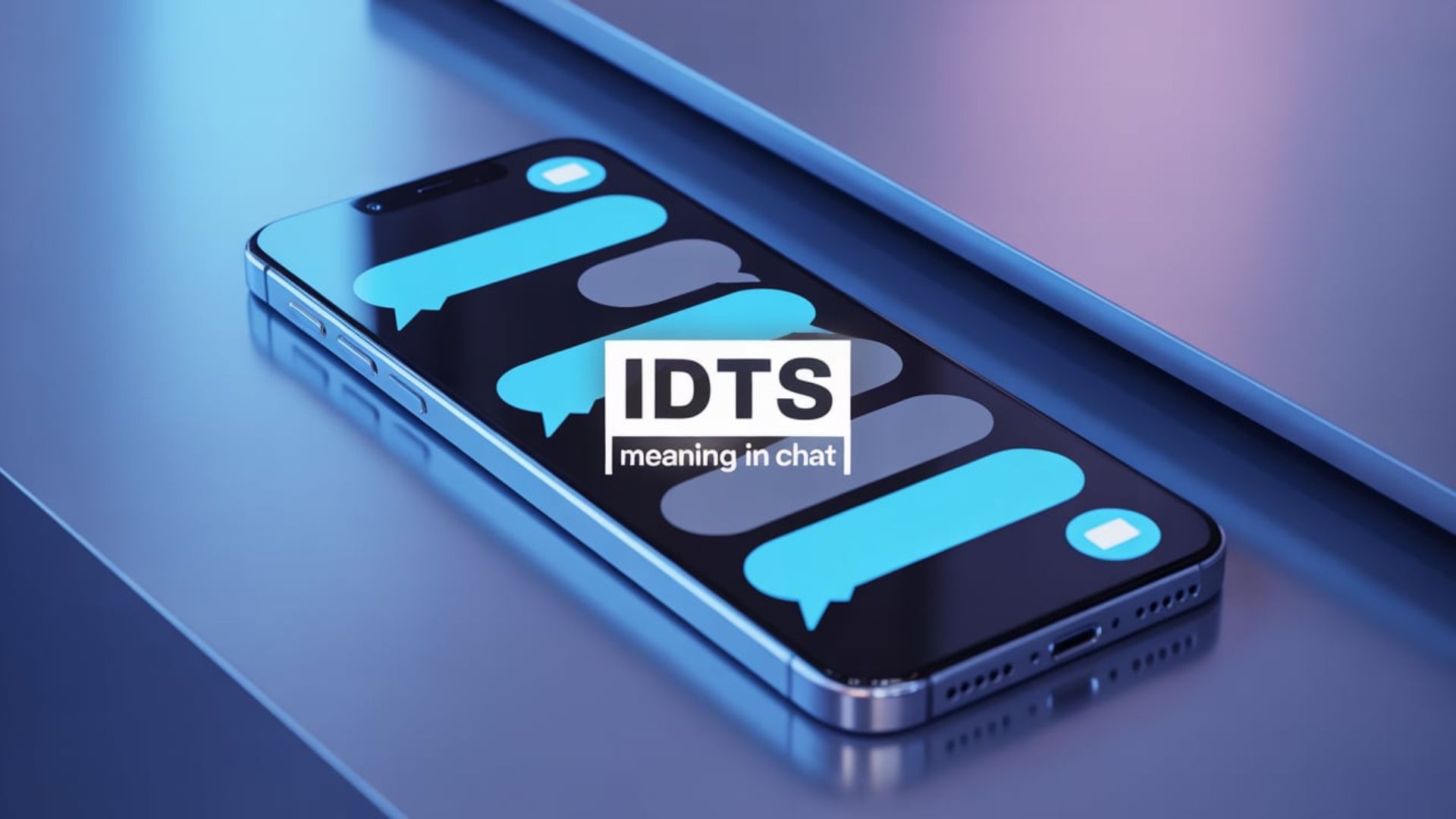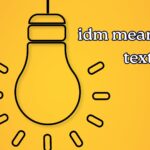IDTS meaning in chat
In today’s digital chats and messaging, you might have noticed someone reply simply with “IDTS” and wondered: What’s going on there? The acronym stands for “I don’t think so”. It expresses a mild disagreement, skepticism or soft “no” in informal conversation.
So when someone asks: “Do you want to finish this tonight?” and you reply “IDTS”, you’re saying: I don’t think so but in casual shorthand. Knowing its meaning is helpful if you want to understand the tone of chat messages or use abbreviations responsibly.
Why It Matters
Using or seeing “IDTS” means you’re engaging with modern, informal digital speech. But tone, audience and context matter. Written shorthand like this can feel abrupt, unprofessional, or even dismissive if used in the wrong setting.
So learning not only the idts meaning in chat but also how to replace it with more polite or professional alternatives becomes useful especially in 2025 when remote and hybrid communication is everywhere.
Let’s dig deeper into the full form, variations, how to use it (and when not to), and some good alternatives you can deploy instead.
The Full Form: “IDTS Full Form in Chat”
The phrase idts full form in chat is simply “I don’t think so”.
In full: I (don’t) think so. That’s its most common meaning in messaging, texting, and online chat.
Because we also include other search terms like “idts full form in chat whatsapp”, “idts full form in chat pakistan”, and “idts full form in chat in hindi”, it’s worth adding: yes the full form remains the same, even if the user is in Pakistan, or chatting on WhatsApp, or writing in a bilingual Hindi-English mix.
The idea is the same: a shorthand way of saying I don’t think so.
The key point: if you see “IDTS”, treat it as “I don’t think so”.
“I don’t think so”: Meaning and Nuance
When you respond with IDTS, you are signalling one of the following:
- You doubt the statement (“That’s not quite right”).
- You disagree, but gently.
- You decline a proposition without outright “no”.
For example:
Chat between friends:
Friend: “We’ll finish the project tonight and still go for dinner, right?”
You: “IDTS got some other calls.”
Here, you’re saying I don’t think so in shorthand. It’s quick and casual.
Because of this informal tone, using “IDTS” in professional emails, formal messages or to someone you don’t know well can seem too casual or even dismissive. That leads us to think about alternatives.
Scenario Examples of IDTS in Use
Scenario 1: Casual text with a friend
Sam (chat): “Do you want to join us at that late-night game?”
You: “IDTS early meeting tomorrow.”
Here you use “IDTS” to politely decline.
Scenario 2: WhatsApp group in Pakistan
Ali (WhatsApp): “Yaar, plan for rooftop party tonight?”
You: “IDTS full form in chat pakistan would still be ‘I don’t think so’ maybe another time.”
Here you still use the same full form, but you mention the context.
Scenario 3: Informal email (not fully professional)
Subject: Weekend plan
Hi Priya,
Thanks for including me in the plan. IDTS, I’ll be out of town. Let’s catch up next weekend.
Best, Raj
In this example, you could use “IDTS”, though in many workplace settings a fuller phrase is better.
Scenario 4: Bilingual chat (Hindi/English)
Friend: “Kal subah 7 am gym karte hain?”
You: “IDTS, bro subah thodi der hogi.”
Here you mix Hindi and English but use “IDTS” in its shorthand role.
Other Similar Acronyms You Might See
Since you asked to include certain key phrases, let’s treat these briefly:
- IDT full form: “I don’t think”. That is, a shorter version of “I don’t think so”.
- ISTG full form in chat: “I swear to God”. Used often to show strong sincerity or frustration.
- IG full form in chat: In many cases “I guess” (or as the social platform name Instagram). Use depends on context.
- DW full form in chat: “Don’t worry”. Common in reassuring messages.
- TBH full form: “To be honest”. Commonly used to preface a candid statement.
Including these helps you see how IDTS fits into a broader landscape of digital shorthand.

Polite and Professional Alternatives to “IDTS”
Since using “IDTS” is fine in casual settings, but may sound too abrupt in formal or semi-formal ones, here are alternatives you can use depending on tone and audience.
| Setting | Instead of “IDTS” say… |
|---|---|
| Formal email to a colleague | “I’m not convinced that’s correct.” |
| Professional meeting follow-up | “I don’t believe that’s quite accurate, based on the data.” |
| Friendly chat but want to soften tone | “I’m not sure that works, maybe we look at it differently.” |
| Urban workplace slack message | “That may not be the case I’ll check and get back to you.” |
| Direct but respectful disagreement | “I’d have to disagree with that conclusion.” |
Examples:
- Email: “Hi Maria, thanks for your suggestion. I don’t believe that’s accurate, given the latest report.”
- Slack: “Thanks, Tom. I’m not convinced yet we should review the figures first.”
- Chat with friend: “Hey Zoey, I don’t think so that idea might be tough with our schedule.”
By using these, you preserve clarity and respect, especially when you’re communicating in a professional context.
When to Avoid “IDTS”
- When writing to a client or senior executive use full wording and maintain formality.
- In academic papers or official documentation texting shorthand is too casual.
- If the audience might not know the abbreviation ambiguity can confuse rather than help.
- When sensitive topics are involved you risk sounding dismissive or curt.
Special Contexts: “IDTS Full Form in Physiotherapy” etc
You asked about “idts full form in physiotherapy”. While I didn’t find a recognized acronym “IDTS” specific to physiotherapy in scholarly literature, online slang sites state “IDTS” means “I don’t think so” in general digital chat.
So if a physiotherapist or patient uses “IDTS” in a chat, unless nervous they’re using a specialized clinical acronym (which is unlikely), you should interpret it in the same way: I don’t think so.
Of course in a medical or physiotherapy-session context, clearer wording is always better.
Common Misunderstandings & Mistakes
- Because many abbreviations look similar, “IDTS” could be misread or mis-typed as “IDST”, “IDT”, etc. So clarity matters.
- Some users unfamiliar with the slang might interpret the message as curt or rude. You’ll often see that with “IDTS” used alone, without context. In other words, tone = important.
- Assuming “IDTS” means something else always consider context. Just because “IDTS” shows up in a medical chat doesn’t mean it has a clinical meaning.
- Using “IDTS” in a professional email may erode credibility or sound unprofessional. It’s fine among friends but not in formal writing.
Why Learn This in 2025?
Digital communication keeps evolving. As we move further into remote work, global messaging apps, bilingual chats (e.g., English + Urdu + Hindi) and hybrid settings, understanding shorthand acronyms helps you:
- Avoid miscommunication
- Adjust tone appropriately
- Present professionally when needed
Whether you’re in Lahore, Karachi, Islamabad, or messaging internationally knowing “idts meaning in chat” and deciding when to use it (or not) makes you more linguistically savvy.
Additional Scenario Examples
Internal work chat
Manager (email): “We’ll send the final draft to the client by tomorrow noon, correct?”
You (reply): “Hi Anna, I’m not entirely sure we can meet noon given the delay in responses.”
Here you avoid “IDTS,” opting for a softer, professional alternative.
WhatsApp group with clients
Client: “We expect all metrics to be updated by 5 pm today.”
You: “That may not be correct I’ll update you by end of day with an accurate timeline.”
Again, more formal.
Mixed language chat (Hindi/English)
Friend: “Kal subah run karte hain 5 am?”
You: “IDTS subah thodi der hogi minutely, chalega 6?”
Casual, friendly, clear.
Bilingual professional WhatsApp (Pakistan)
Colleague: “Are we okay to ship the sample today?”
You: “Thanks, Ali. I don’t think that’s accurate we’re awaiting QC approval still.”
Polite, professional.
Summary
- The acronym IDTS stands for “I don’t think so”.
- It is used in chat and texting to express doubt/disagreement but is informal.
- Other related acronyms: IDT (“I don’t think”), ISTG (“I swear to God”), IG (“I guess”), DW (“Don’t worry”), TBH (“To be honest”) all depend on context.
- Use polite/professional alternatives when speaking with colleagues, clients, or in formal writing.
- Avoid over-relying on shorthand in ambiguous or formal situations.
- Being aware of such acronyms helps you decode digital chats and communicate more effectively in 2025.









